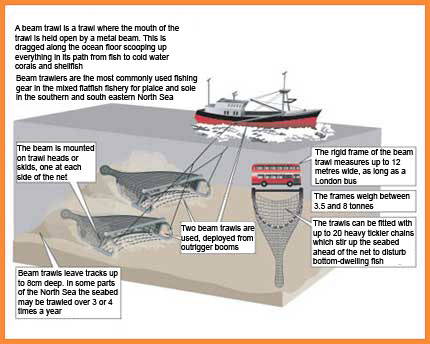Beam trawling
“Fishing with modern technology is the most destructive activity on Earth”Charles Clover, Environment Correspondent, Daily Telegraph
|
What is beam trawling?
Beam trawling is one of the most destructive form of bottom trawling, in which a large net attached to a heavy metal beam is dragged across the sea bed behind a boat, digging into and ploughing up the ground. The beam, which can be up to 12m long, keeps the net open horizontally while metal frames at each end keep it open vertically. Beam trawlers tow two nets, one each side of the vessel. On larger boats, several tons of ‘tickler’ chains can be used ahead of the ground rope to raise fish which may otherwise be crushed by the beam.
The target species are usually shrimp or bottom-dwelling flat-fish such as plaice and sole, but its indiscriminate nature means that hundreds of other species with no commercial value are killed in the process. In the fishing industry these unwanted species are known by the deliberately inoffensive term ‘bycatch’.
 The true cost of beam trawling
The true cost of beam trawling
Decades of overfishing in the pelagic zone (the mid-water areas of the sea where tuna, mackerel, herring and sea-bass used to be plentiful) has led to a dramatic growth in all forms of bottom-trawling. According to Daily Telegraph environment correspondent Charles Clover, “the global fishing fleet is estimated to be two and a half times greater than needed to catch what the ocean can sustainably produce,” and that modern industrial fishing has turned our seas into “a vast killing field filled with technologically sophisticated deep-ocean fleets from the First World devastating the waters of the Third.”
Why should this concern us? Well, next time you sit down to a plate of beam-trawled plaice or Dover Sole (and almost all them are fished in this way unless it specifically says otherwise on the label), imagine that up to three times that number of other sea creatures (by weight) died in the process of taking them from the ocean – including fish, crabs, sponges and corals. Much of this ‘bycatch’ is made up of rare and slow growing species which will take decades to recover, and some of which may be as yet unknown to science.
“Consumer power and the demand for sustainably caught fish may be the most direct route to change”
David Milliband, former Environment Minister, UK government
By any standards this is shockingly wasteful – the only possible excuse is ignorance. But, as in the case of climate change, ignorance is no longer an option. And there are signs that our government is waking up to the fact that this state of affairs cannot continue. Recently former Environment Minister David Milliband blogged that the failure to introduce a sustainable policy represented
“an incredibly depressing catalogue of shortsightedness, myopia, you name it. Talk about cutting off your nose to spite your face but we are basically eating away our own future in the pretty clear knowledge that we are doing so.”
His solution? Recognising the degree to which government is dominated by big business interests he reluctantly concludes that “Consumer power and the demand for sustainably caught fish may be the most direct route to change.”
Greenpeace believes this too – because 90 per cent of seafood retailed in Britain is sold through supermarkets. Change will happen only when enough of us as individual consumers send a message to them that this destruction must stop or we will no longer use them. But the message is beginning to get through – both Marks & Spencer and Waitrose have begun to remove beam trawled products from their shelves, while Iceland, as part of its new seafood policy, removed 50% of their flatfish range in Sept 2006 to reduce beam trawl use. Now we need your help to keep up the pressure. Your voice as a consumer can make a difference. In fact it’s one of the only things that will!
We’re calling for an immediate halt to deep sea bottom trawling. If it is allowed to continue, we will lose countless more species before they have even been discovered.

